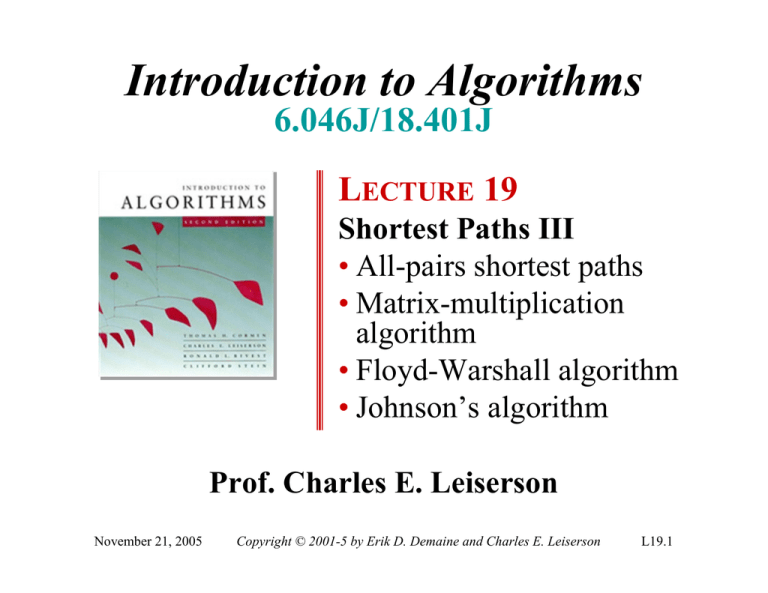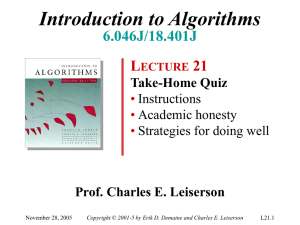Introduction to Algorithms 6.046J/18.401J 9 L
advertisement

Introduction to Algorithms
6.046J/18.401J
LECTURE 19
Shortest Paths III
• All-pairs shortest paths
• Matrix-multiplication
algorithm
• Floyd-Warshall algorithm
• Johnson’s algorithm
Prof. Charles E. Leiserson
November 21, 2005
Copyright © 2001-5 by Erik D. Demaine and Charles E. Leiserson
L19.1
Shortest paths
Single-source shortest paths
• Nonnegative edge weights
Dijkstra’s algorithm: O(E + V lg V)
• General
Bellman-Ford algorithm: O(VE)
• DAG
One pass of Bellman-Ford: O(V + E)
November 21, 2005
Copyright © 2001-5 by Erik D. Demaine and Charles E. Leiserson
L19.2
Shortest paths
Single-source shortest paths
• Nonnegative edge weights
Dijkstra’s algorithm: O(E + V lg V)
• General
Bellman-Ford: O(VE)
• DAG
One pass of Bellman-Ford: O(V + E)
All-pairs shortest paths
• Nonnegative edge weights
Dijkstra’s algorithm |V| times: O(VE + V 2 lg V)
• General
Three algorithms today.
November 21, 2005
Copyright © 2001-5 by Erik D. Demaine and Charles E. Leiserson
L19.3
All-pairs shortest paths
Input: Digraph G = (V, E), where V = {1, 2,
…, n}, with edge-weight function w : E → R.
Output: n × n matrix of shortest-path lengths
δ(i, j) for all i, j ∈ V.
November 21, 2005
Copyright © 2001-5 by Erik D. Demaine and Charles E. Leiserson
L19.4
All-pairs shortest paths
Input: Digraph G = (V, E), where V = {1, 2,
…, n}, with edge-weight function w : E → R.
Output: n × n matrix of shortest-path lengths
δ(i, j) for all i, j ∈ V.
IDEA:
• Run Bellman-Ford once from each vertex.
• Time = O(V 2E).
• Dense graph (n2 edges) ⇒ Θ(n 4) time in the
worst case.
Good first try!
November 21, 2005
Copyright © 2001-5 by Erik D. Demaine and Charles E. Leiserson
L19.5
Dynamic programming
Consider the n × n adjacency matrix A = (aij)
of the digraph, and define
dij(m) = weight of a shortest path from
i to j that uses at most m edges.
Claim: We have
0 if i = j,
(0)
dij =
∞ if i ≠ j;
and for m = 1, 2, …, n – 1,
dij(m) = mink{dik(m–1) + akj }.
November 21, 2005
Copyright © 2001-5 by Erik D. Demaine and Charles E. Leiserson
L19.6
Proof of claim
k’s
dij(m) = mink{dik(m–1) + akj }
es
g
d
1e
ii
–
m
≤
s
e
g
d
e
1
≤m–
≤m
–1
edg
es
jj
M
≤ m – 1 edges
November 21, 2005
Copyright © 2001-5 by Erik D. Demaine and Charles E. Leiserson
L19.7
Proof of claim
k’s
dij(m) = mink{dik(m–1) + akj }
es
g
d
1e
ii
Relaxation!
–
m
≤
s
e
g
d
e
1
≤m–
≤m
–1
edg
es
for k ← 1 to n
do if dij > dik + akj
then dij ← dik + akj
November 21, 2005
jj
M
≤ m – 1 edges
Copyright © 2001-5 by Erik D. Demaine and Charles E. Leiserson
L19.8
Proof of claim
k’s
dij(m) = mink{dik(m–1) + akj }
es
g
d
1e
ii
Relaxation!
–
m
≤
s
e
g
d
e
1
≤m–
≤m
–1
edg
es
for k ← 1 to n
do if dij > dik + akj
then dij ← dik + akj
jj
M
≤ m – 1 edges
Note: No negative-weight cycles implies
δ(i, j) = dij (n–1) = dij (n) = dij (n+1) = L
November 21, 2005
Copyright © 2001-5 by Erik D. Demaine and Charles E. Leiserson
L19.9
Matrix multiplication
Compute C = A · B, where C, A, and B are n × n
matrices:
n
cij = ∑ aik bkj .
k =1
Time = Θ(n3) using the standard algorithm.
November 21, 2005
Copyright © 2001-5 by Erik D. Demaine and Charles E. Leiserson
L19.10
Matrix multiplication
Compute C = A · B, where C, A, and B are n × n
matrices:
n
cij = ∑ aik bkj .
k =1
Time = Θ(n3) using the standard algorithm.
What if we map “+” → “min” and “·” → “+”?
November 21, 2005
Copyright © 2001-5 by Erik D. Demaine and Charles E. Leiserson
L19.11
Matrix multiplication
Compute C = A · B, where C, A, and B are n × n
matrices:
n
cij = ∑ aik bkj .
k =1
Time = Θ(n3) using the standard algorithm.
What if we map “+” → “min” and “·” → “+”?
cij = mink {aik + bkj}.
Thus, D(m) = D(m–1) “×” A.
Identity matrix = I =
November 21, 2005
⎛ 0 ∞ ∞ ∞⎞
⎜∞ 0 ∞ ∞⎟
⎜∞ ∞ 0 ∞⎟
⎜∞ ∞ ∞ 0 ⎟
⎝
⎠
= D0 = (dij(0)).
Copyright © 2001-5 by Erik D. Demaine and Charles E. Leiserson
L19.12
Matrix multiplication
(continued)
The (min, +) multiplication is associative, and
with the real numbers, it forms an algebraic
structure called a closed semiring.
Consequently, we can compute
D(1) = D(0) · A = A1
D(2) = D(1) · A = A2
M
M
D(n–1) = D(n–2) · A = An–1 ,
yielding D(n–1) = (δ(i, j)).
Time = Θ(n·n3) = Θ(n4). No better than n × B-F.
November 21, 2005
Copyright © 2001-5 by Erik D. Demaine and Charles E. Leiserson
L19.13
Improved matrix
multiplication algorithm
Repeated squaring: A2k = Ak × Ak.
⎡lg(n–1)⎤
2
4
2
.
Compute A , A , …, A
O(lg n) squarings
Note: An–1 = An = An+1 = L.
Time = Θ(n3 lg n).
To detect negative-weight cycles, check the
diagonal for negative values in O(n) additional
time.
November 21, 2005
Copyright © 2001-5 by Erik D. Demaine and Charles E. Leiserson
L19.14
Floyd-Warshall algorithm
Also dynamic programming, but faster!
Define cij(k) = weight of a shortest path from i
to j with intermediate vertices
belonging to the set {1, 2, …, k}.
ii
≤≤ kk
≤≤ kk
≤≤ kk
≤≤ kk
jj
Thus, δ(i, j) = cij(n). Also, cij(0) = aij .
November 21, 2005
Copyright © 2001-5 by Erik D. Demaine and Charles E. Leiserson
L19.15
Floyd-Warshall recurrence
cij(k) = mink {cij(k–1), cik(k–1) + ckj(k–1)}
cik
ii
(k–1)
k
cij(k–1)
ckj(k–1)
jj
intermediate vertices in {1, 2, …, k}
November 21, 2005
Copyright © 2001-5 by Erik D. Demaine and Charles E. Leiserson
L19.16
Pseudocode for FloydWarshall
for k ← 1 to n
do for i ← 1 to n
do for j ← 1 to n
do if cij > cik + ckj
then cij ← cik + ckj
relaxation
Notes:
• Okay to omit superscripts, since extra relaxations
can’t hurt.
• Runs in Θ(n3) time.
• Simple to code.
• Efficient in practice.
November 21, 2005
Copyright © 2001-5 by Erik D. Demaine and Charles E. Leiserson
L19.17
Transitive closure of a
directed graph
Compute tij =
1 if there exists a path from i to j,
0 otherwise.
IDEA: Use Floyd-Warshall, but with (∨, ∧) instead
of (min, +):
tij(k) = tij(k–1) ∨ (tik(k–1) ∧ tkj(k–1)).
Time = Θ(n3).
November 21, 2005
Copyright © 2001-5 by Erik D. Demaine and Charles E. Leiserson
L19.18
Graph reweighting
Theorem. Given a function h : V → R, reweight each
edge (u, v) ∈ E by wh(u, v) = w(u, v) + h(u) – h(v).
Then, for any two vertices, all paths between them are
reweighted by the same amount.
November 21, 2005
Copyright © 2001-5 by Erik D. Demaine and Charles E. Leiserson
L19.19
Graph reweighting
Theorem. Given a function h : V → R, reweight each
edge (u, v) ∈ E by wh(u, v) = w(u, v) + h(u) – h(v).
Then, for any two vertices, all paths between them are
reweighted by the same amount.
Proof. Let p = v1 → v2 → L → vk be a path in G. We
k −1
have
wh ( p ) =
=
∑ wh ( vi ,vi+1 )
i =1
k −1
∑ ( w( vi ,vi+1 )+ h ( vi )− h ( vi+1 ) )
i =1
k −1
=
∑ w( vi ,vi+1 ) + h ( v1 ) − h ( vk ) Same
i =1
= w ( p ) + h ( v1 ) − h ( v k ) .
November 21, 2005
amount!
Copyright © 2001-5 by Erik D. Demaine and Charles E. Leiserson
L19.20
Shortest paths in reweighted
graphs
Corollary. δh(u, v) = δ(u, v) + h(u) – h(v).
November 21, 2005
Copyright © 2001-5 by Erik D. Demaine and Charles E. Leiserson
L19.21
Shortest paths in reweighted
graphs
Corollary. δh(u, v) = δ(u, v) + h(u) – h(v).
IDEA: Find a function h : V → R such that
wh(u, v) ≥ 0 for all (u, v) ∈ E. Then, run
Dijkstra’s algorithm from each vertex on the
reweighted graph.
NOTE: wh(u, v) ≥ 0 iff h(v) – h(u) ≤ w(u, v).
November 21, 2005
Copyright © 2001-5 by Erik D. Demaine and Charles E. Leiserson
L19.22
Johnson’s algorithm
1. Find a function h : V → R such that wh(u, v) ≥ 0 for
all (u, v) ∈ E by using Bellman-Ford to solve the
difference constraints h(v) – h(u) ≤ w(u, v), or
determine that a negative-weight cycle exists.
• Time = O(V E).
2. Run Dijkstra’s algorithm using wh from each vertex
u ∈ V to compute δh(u, v) for all v ∈ V.
• Time = O(V E + V 2 lg V).
3. For each (u, v) ∈ V × V, compute
δ(u, v) = δh(u, v) – h(u) + h(v) .
• Time = O(V 2).
Total time = O(V E + V 2 lg V).
November 21, 2005
Copyright © 2001-5 by Erik D. Demaine and Charles E. Leiserson
L19.23




